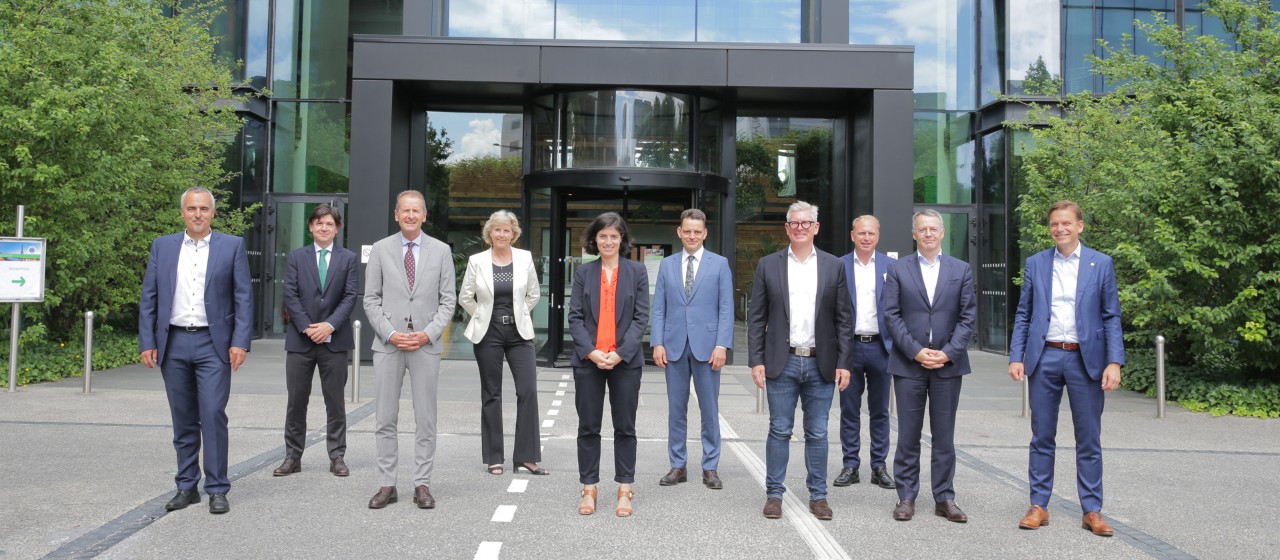
As a part of the cross-industry CEO Alliance, Scania backs EU plan to cut carbon emissions by 55% by 2030
8 JULY 2021
The CEO Alliance with 12 business leaders recently met in Paris to discuss ways to further support the EU Green Deal. The group believes that fighting climate change will require a collective effort by all EU member states and collaboration between the public sector and industry. A strong carbon pricing signal on the European level is regarded as a key to achieving carbon neutrality by 2050 and cutting greenhouse gas emissions to 55 percent of 1990 levels by 2030.
As the EU Commission prepares to present its Fit for 55 legislative package, the European CEO Alliance has issued policy recommendations supporting a progressive and ambitious push to achieve climate neutrality. Tackling climate change requires strong collaboration between the public sector and industry, the Alliance announced after its meeting on July 7th in Paris. The Alliance would welcome a review of the EU’s major regulatory instruments, in particular subsidies for technologies with high CO2 emissions. The CEOs’ proposals include sending a strong carbon pricing signal, accelerating measures to decarbonize mobility and transport, buildings and energy systems, speeding up the renewal of key industry sectors in the EU.
"I am very pleased to have been able to exchange views today with the companies that provide solutions for the implementation of the Green Deal, the decarbonization of the economy, green transition and energy efficiency. As the European Commission prepares to present its ‘Fit for 55’ energy and climate package with measures to reduce greenhouse gas emissions by 55 percent in 2030 and achieve carbon neutrality in 2050, the mobilization of industrial and economic players will be essential to achieving our climate objectives together. "said Clément Beaune, Secretary of State for European Affairs in the French government.
Scania is fully committed to the Paris Agreement and the climate goals of the EU Commission. We see the road to a sustainable transport system clearly now through biofuels and electrification. The investments in infrastructure are coming and if we can add the dimension of a price on carbon, we will boost the green options and make the fossil ones less attractive. The science is clear and the time to act for both companies and policy makers is now, says Christian Levin, Scania’s CEO.
As one central instrument, Alliance members proposed a strong carbon price signal to achieve the EU’s climate targets. Carbon should have a price across the whole economy. The Alliance also called for continued enhancement of the EU’s Emissions Trading System (for power and heavy industry) and for the implementation of sector-specific cap-and-trade systems that would apply to mobility, transport and the buildings sector. Sector-specific systems could then converge beginning in 2030. Another proposal concerns a European carbon pricing system that would include measures to simultaneously achieve a social balance and emissions reduction.
Decarbonizing mobility, transport and buildings will be the major challenges. For the transport and mobility sector, electric mobility for passenger cars, light vehicles and heavy duty vehicles has proven to be the most efficient technology in terms of energy consumption and emission reduction. To foster the entire ecosystem around electric mobility, members of the CEO Alliance have initiated cross-sectoral projects to ramp up battery production and create a charging infrastructure across Europe.
Turning its attention to the EU Commission’s Buildings Renovation Wave, the Alliance supports ambitious renovation targets (of at least 3% p.a.) to accelerate the transformation of the building stock. Buildings should meet higher standards regarding energy efficiency, renewables and sustainable materials. The Alliance also calls for fossil-fuel heating systems to be rapidly replaced by rolling out electric heat pumps, district heating and digital solutions. The CEOs are committed to applying this recommendation to their companies’ own buildings.
The European climate targets require a rapid build-up of renewable power generation and the direct electrification of mobility, transport and heating/air conditioning for buildings. The CEO Alliance is working on a project to integrate power systems, in particular grids, in order to create a system based mainly on renewables and flexible solutions.
The CEO Alliance for Europe's Recovery, Reform and Resilience was formed in 2020 against the backdrop of the Covid-19 pandemic and the historic European Green Deal. The Alliance’s shared goal is to make the EU the world's leading region for climate protection while unlocking investments, fuelling innovations in new technologies and creating future-proof jobs.
The members view themselves as an “action tank,” working together on cross-sector pan-European projects at scale: cross-EU charging infrastructure for heavy duty trucks, integration of EU power systems (in particular grids), digital carbon footprint tracking, sustainable and healthy buildings for the future of work and living, e-buses for Europe, green hydrogen value chains and the rapid development of battery production. Further projects are being prepared, including one involving low carbon steel. The CEOs will deliver their first tangible results and discuss implementation with high-level EU representatives at a summit set for autumn 2021.
The Alliance brings together 12 top executives from the energy, transport and technology industries: Björn Rosengren (ABB), Thierry Vanlancker (AkzoNobel), Francesco Starace (ENEL), Leonhard Birnbaum (E.ON), Börje Ekholm (Ericsson), Henrik Henriksson (H2GreenSteel), Ignacio Galán (Iberdrola), Frans van Houten (Philips), Christian Klein (SAP), Christian Levin (Scania), Jean-Pascale Tricoire (Schneider Electric) and Herbert Diess (Volkswagen). McKinsey & Company is serving as a knowledge contributor for the CEO Alliance and is providing additional research and data.